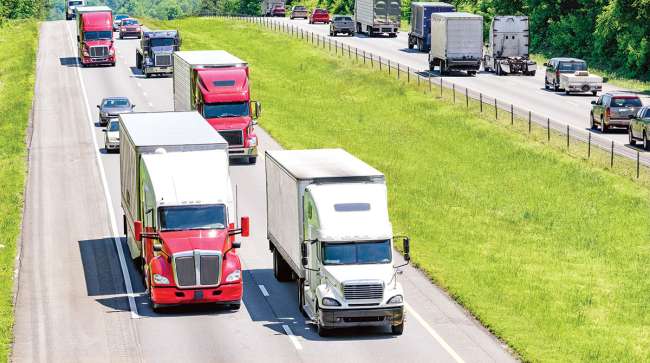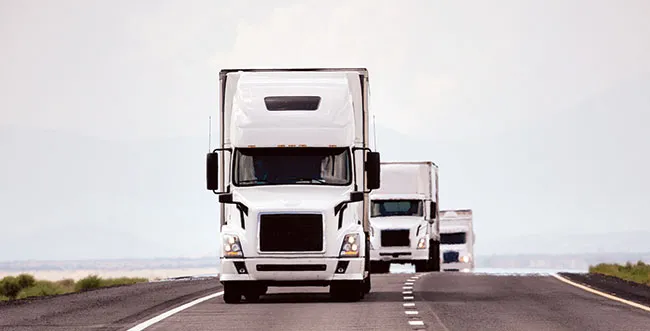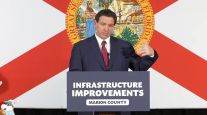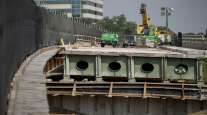Senior Reporter
Road Designers Confront Challenges of Balancing Safety, Function

[Stay on top of transportation news: Get TTNews in your inbox.]
Like most people, Roger Bligh appreciates the natural beauty of trees.
But Bligh, an award-winning roadside safety research engineer, also sees trees as safety hazards. He says when motorists in cars and trucks are forced off highways, they too often slam into them.
“In terms of roadside safety the biggest problem, the issue that creates the most deaths on our roadsides, is still trees,” said Bligh, a researcher for the Texas A&M Transportation Institute (TTI).
In a way, it’s difficult to find a safety fix for a tree bordering a highway, he said.
“It turns out it’s a very sensitive issue, because a lot of the DOTs are not able to just go and cut down all the trees in their right-of-way,” Bligh said. “There are issues surrounding that particular problem that make it more sensitive than some of the others, in terms of environmental issues, health issues, aesthetic issues or whatever it might be.”
Making Roads Safer

Bligh (pictured) at a recent event suggested a list to his fellow road designers that is consistent with some of the goals of the U.S. Department of Transportation’s National Roadway Safety Strategy:
- Develop improved countermeasures to address overrepresenting crash types — such as rollovers and trees.
- Continue addressing vulnerable road users, including motorcyclists, bicycles and pedestrians.
- Providing safer work zones to enhance protections, for not only motorists, but workers.
- Continue training on the proper installations, inspections, repairs and maintenance of safety devices.
- Continue the evolution of standards ranging from concrete barriers to guardrails to include a broader range of crashes.
- Continue the collection and analyses of data in support of data-driven decisions.
- Continue the implementation of improved guidance in hardware for the roadside design guidance.
- Continue the research to understand the impact of electric-connected and autonomous vehicles on roadside safety.
Likewise, Nicole Katsikides, a TTI research scientist who specializes in trucking safety issues, has some concerns about cars.
“One of the biggest problems for safety with trucks — and you’ll hear this from the truckers — is passenger vehicles,” said Katsikides, who also is a member of a number of Transportation Research Board’s trucking and freight-related committees.
She says the Interstate Highway System was constructed in the 1950s for trucks. “It was built to make America competitive, able to move things from one place to another,” Katsikides said.
Her concern is that cars too often don’t seem to give trucks respect; for instance, not understanding they take longer to stop. “So you see a lot of accidents where people do stupid things around trucks,” she mentioned.
Difficult Solutions
Katsikides’ research problem is tough to solve because obviously you can’t take cars off the nation’s highways. She sees truck-only lanes as a best case solution — yet clearly a very expensive one.
Both Bligh and Katsikides are concerned that such examples of safety problems will be tough to solve.
“It can be very daunting when you’re looking at such a large problem,” Bligh said. “We all hope to achieve vision zero one day, reach a point where we have zero deaths on our roadways. But the character of our roadways and vehicles are rapidly changing.”
However, the Infrastructure Investment and Jobs Act of 2021 broke open the biggest piggy bank for infrastructure spending since the 1950s, making billions of dollars available for fixing the nation’s declining roads and bridges, and to add road capacity. More than 36,000 transportation improvement projects — including at least one in every congressional district — have moved forward in the past 16 months as implementation of the IIJA continues, American Road & Transportation Builders Association Chair Paula Hammond told a congressional panel in late March.
She said the infrastructure bill is providing a “much-needed boost over the next five years” to help support modernization of the nation’s multimodal transportation network.
“With year two underway, the law’s enhancements are becoming more apparent,” Hammond said. “From contract awards to construction activity, key market indicators across the project pipeline identify the initial benefits of federal highway investment, despite continued inflation and lingering supply chain issues.”

A truck-only lane. (Doughberry/Getty Images)
Clearly, trucking industry leaders are focused on how that money is spent — hoping not to just repair worn-out bridges and roads and fix potholes, but to expand the interstates and other truck-traveled roads in hope of relief for congestion that costs motor carriers time and money.
Along these lines, Chris Spear, president of American Trucking Associations, in February urged Congress to block federal policies that are likely to prevent or hamstring state and local agencies’ efforts to expand highway capacity.
Spear said ATA is concerned about a Dec. 16, 2021, Federal Highway Administration memo to its staff that outlined administration policies with regard to the federal-aid highway program.
The memo, in part, directed staff to “encourage” states and other federal aid recipients to prioritize roadway maintenance and nonhighway modal projects over the construction of new highway capacity, Spear said. Latest estimates to add capacity range by state from 4% to 61% of project money.
“There is a significant amount of funding for trucking in the IIJA, especially for freight movement barriers.” Katsikides said. “One of the [categories] expanded eligibility to use it to do more things to support freight movement. By more things I mean improvements like technologies, investment in roadways, capacity expansion and truck parking.”

Katsikides
She added, “I hear often that people say there isn’t money for truck parking. There is, but in some areas all these things compete with each other. “It’s really challenging for state DOT officials, even with the funding that’s available, because often there’s opposition by local governments.”
Katsikides said some state and federal agencies are trying to move toward performance-based testing. “There’s a lot more data available now than there ever has been. Performance-based planning is using data to make decisions, and to evaluate the system.”
TRB is a research-based enterprise, and a part of the group’s mission is to identify research needs and promote that research, and try to find ways for it to get addressed and funded at various levels, Bligh said. All of the committees are made up of subject-matter experts, and are aware of areas of need or those that can be improved, are drafting up research problem statements with a goal of funding and execution.
“A lot of this information is data-driven. There’s a lot of crash data out there,” Bligh added.
How competitive is it to get funding for researchers’ safety projects?
“You try to make data-based decisions to use those pots of money from the state formula funding programs,” Katsikides said. “It is a bit of a hodge-podge. Sometimes states are trying to make it data driven, but other times there are political pressures involved, or community pressures.
Setting a Standard
Nonetheless, the infrastructure legislation has resulted in a new way to examine the increases in roadway fatalities in recent years. The Department of Transportation calls its most recent program to turn around the dismal trend the National Roadway Safety Strategy.
At the core of this strategy is a departmentwide adoption of the Safe System Approach, which focuses on five key objectives: safer people, safer roads, safer vehicles, safer speeds and post-crash care, according to DOT documents. “We will launch new programs, coordinate and improve existing programs, and adopt a foundational set of principles to guide this strategy.”
DOT said the “safe system approach,” which researchers say is gaining traction, differs significantly from a conventional safety approach. It incorporates the following principles:
- Death and serious injuries are unacceptable.
- Humans make mistakes.
- Humans are vulnerable.
- Responsibility is shared.
- Safety is proactive.
- Redundancy is crucial.
The focus of a safe system is on preventing death and serious injury rather than to prevent crashes, according to a 2021 meeting of the Johns Hopkins Center for Injury Research and Policy and the Institute of Transportation Engineers. The meeting was aimed at “reimagining” road safety and equity in the U.S. The Safe System has been used in many countries and resulted in some successes, according to the meeting report.
Some freight funding provisions in the IIJA:
- National Highway Freight Program. The IIJA provides $7.15 billion nationally for the National Highway Freight Program guaranteed apportionment between fiscal year 2022 and fiscal year 2026. NHFP exists to support projects that will improve efficient movement of freight on the National Highway Freight Network.
- Nationally Significant Freight and Highway Projects. The IIJA provides $8 billion over five years (averaging $1.6 billion a year) for the Infrastructure Rebuilding America competitive grant program for freight projects.
- National Infrastructure Project Assistance Program. The IIJA creates a new program for mega-projects competitive grants. The new program provides $5 billion for single- or multiyear grants to such projects generating national or regional economic, mobility or safety benefits for eligible projects including highway or bridge projects, freight intermodal or freight rail projects, and railway-highway grade separation or elimination projects.
- Reduction of Truck Emissions at Port Facilities. The IIJA establishes a $400 million program to reduce idling and emissions at port facilities. IIJA requires DOT to study how ports would benefit from electrification and to study emerging technologies that reduce emissions from idling trucks. It also requires DOT to coordinate and fund projects through competitive grants that reduce port-related emissions from idling trucks.
“[We are] frustrated that conventional safety approaches have not shifted the rank of traffic deaths as the leading cause of death for young people and with the associated endemic inequities rooted in our road transportation system,” according to the report by the group of engineers, scientists, public health professionals and safety experts.
“Cars can be repaired, human bodies often cannot,” the report said. “Reducing crash forces and protecting road users is the key.”
“The safe system approach begins with a commitment to eliminate fatalities and serious injuries among all road users, and uses thoughtful road and vehicle design to minimize crashes that occur when people make mistakes, and to reduce crash forces so that people are less likely to be injured when crashes occur,” the report said.
The report said that people behave in a “repeated and predictable way.”
“The road system should assist them in doing the right thing and reduce opportunities for errors or mistakes,” the report said. “This does not absolve road users from their obligation to behave safely, but acknowledges that safety progress requires collective responsibility.”
Much of the work related to road design actually begins with research by transportation-related government agencies, and in the hundreds of committees operating within TRB that bring thousands of academics, researchers, government officials and other transportation executives to an annual conference in the nation’s capitol.
“When we talk about roadside safety, we’re not just talking about increasing the frequency of these accidents,” Bligh said. “But if a crash does occur and someone does leave the roadway for whatever reason, we want to then try and reduce the severity of that encroachment.”
Bligh added: “When we’re talking about large trucks, sometimes the consequence of a truck going through or over a barrier can be catastrophic. So there are times when we want to provide safety features and safety devices that have the ability to contain these heavy vehicles and keep them from encountering whatever is behind a barrier system.”
That’s why there are higher, more expensive, bridge rail systems for heavy trucks, he said.
Want more news? Listen to today's daily briefing below or go here for more info:




